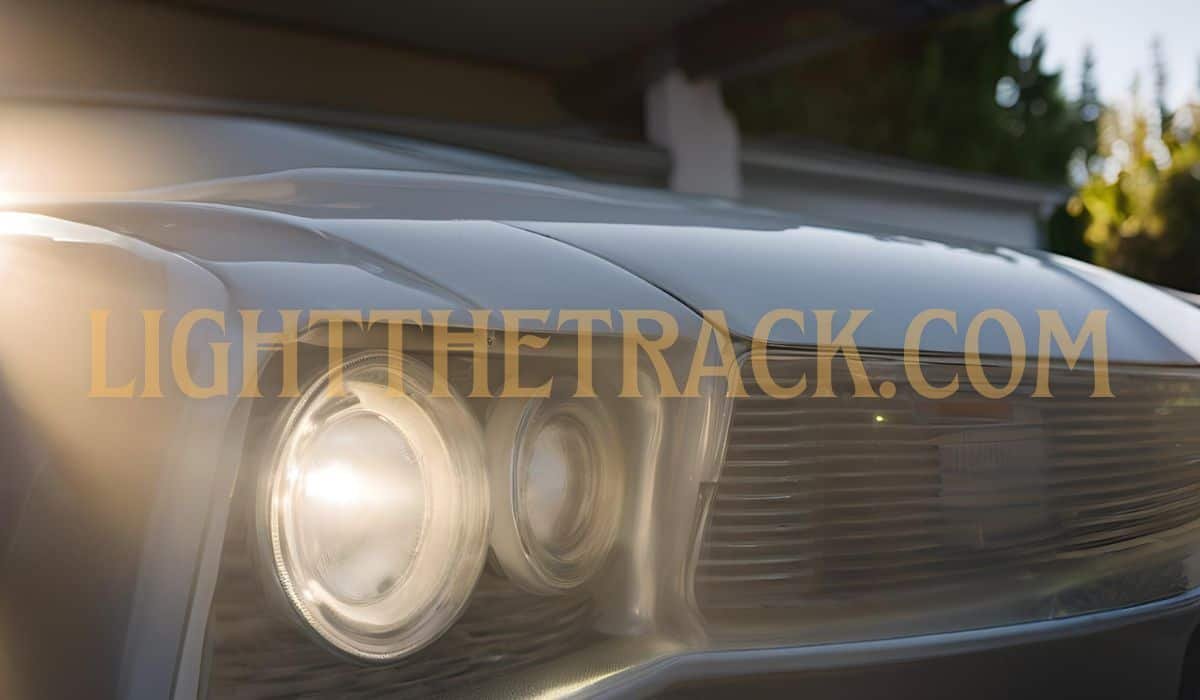In today’s fast-paced world, driving safely is paramount, especially when navigating through the darkness of night or challenging weather conditions. One often overlooked aspect of vehicle maintenance that plays a crucial role in ensuring safety on the road is the care of your car’s headlights. Over time, headlights can become foggy, significantly reducing their effectiveness and compromising your visibility. This comprehensive guide will walk you through everything you need to know about foggy headlights, from understanding the problem to cleaning and maintaining them for optimal performance.
Understanding Foggy Headlights
What are foggy headlights?
Foggy headlights are a common issue that many vehicle owners face. This phenomenon occurs when the clear plastic lenses covering your headlights become cloudy, hazy, or yellowed. The result is a significant reduction in the amount and quality of light emitted from your headlights, which can severely impact your ability to see clearly while driving at night or in poor weather conditions.
Causes of foggy headlights
Several factors contribute to the fogging of headlights:
- UV radiation exposure: The primary culprit is often the sun’s ultraviolet rays, which gradually break down the protective coating on the headlight lenses.
- Oxidation: The polycarbonate plastic used in modern headlight lenses can oxidize over time, leading to a cloudy appearance.
- Environmental factors: Pollutants, road debris, and harsh weather conditions can accelerate the deterioration of headlight lenses.
- Chemical reactions: The breakdown of the plastic itself can lead to chemical changes that cause fogging.
May you like: Do led need ballast
Why headlights become foggy over time
The process of headlight fogging is gradual and often goes unnoticed until it becomes severe. Here’s a breakdown of what happens:
- The protective UV coating on the headlight lens begins to deteriorate.
- As the coating breaks down, the polycarbonate plastic underneath becomes exposed.
- UV rays and environmental factors cause the exposed plastic to oxidize and degrade.
- The degraded plastic absorbs blue light from the headlight bulbs, resulting in a yellowish, dim light output.
The Importance of Clear Headlights
Safety considerations
Clear headlights are not just about aesthetics; they’re a critical safety feature of your vehicle. Here’s why:
- Improved visibility for drivers: Clean, clear headlights provide better illumination of the road ahead, allowing you to spot potential hazards earlier.
- Better visibility to other road users: Bright, properly functioning headlights make your vehicle more visible to other drivers, pedestrians, and cyclists.
Read more: resilvering headlight reflectors
Legal requirements
Many jurisdictions have specific laws regarding headlight maintenance:
- Most states require headlights to be visible from a certain distance (typically 500-1000 feet).
- Driving with excessively foggy headlights can result in fines or failed vehicle inspections.
Also read: Brake light bulb replacement cost
Aesthetic benefits
While safety is paramount, there are aesthetic advantages to maintaining clear headlights:
- Improved overall appearance of your vehicle
- Potential increase in resale value, as clear headlights suggest a well-maintained car
Materials and Products for Cleaning Foggy Headlights
DIY cleaning solutions
For those who prefer a home remedy approach, several household items can be effective:
- Toothpaste and baking soda mixture:
- Mix equal parts toothpaste (preferably whitening) and baking soda
- Creates a mildly abrasive paste that can remove oxidation
- Vinegar and baking soda:
- Mix to form a paste
- Effective for light to moderate fogging
- Soap and water:
- A gentle solution for regular maintenance
- Not effective for severe fogging
Commercial headlight restoration kits
Many auto parts stores offer specialized kits designed for headlight restoration. These typically include:
- Cleaning solution
- Sandpaper of various grits
- Polishing compound
- UV-resistant clear coat
Tools and accessories
Regardless of the cleaning method you choose, you’ll need some basic tools:
- Microfiber cloths
- Masking tape
- Latex gloves
- Spray bottle for water
- Soft-bristled brush
You need to know: are led headlights illegal in california
Step-by-Step Guide to Cleaning Foggy Headlights
Preparation
- Wash the entire headlight assembly with soap and water to remove surface dirt.
- Dry thoroughly with a microfiber cloth.
- Use masking tape to protect the paint around the headlight.
Cleaning methods
1. Using a DIY solution
- Apply your chosen DIY paste to the headlight lens.
- Using a microfiber cloth, gently rub the paste in circular motions.
- Continue for 5-10 minutes, adding more paste as needed.
- Rinse thoroughly with clean water.
- Dry with a clean microfiber cloth.
2. Using a commercial kit
- Follow the manufacturer’s instructions carefully.
- Typically, you’ll start with the coarsest sandpaper and work your way to finer grits.
- Sand in a consistent pattern, keeping the lens wet.
- After sanding, apply the polishing compound.
- Buff the lens to a clear finish.
Applying a protective coating
After cleaning, it’s crucial to protect the lens from future damage:
- Ensure the lens is completely clean and dry.
- Apply a UV-resistant clear coat according to the product instructions.
- Allow the coating to dry fully before exposing the headlights to moisture.
Maintenance tips
- Clean your headlights regularly with soap and water to prevent buildup.
- Apply a UV-resistant sealant every 6-12 months.
Advanced Techniques for Severe Fogging
Wet sanding method
For headlights with severe oxidation:
- Start with 1000-grit wet/dry sandpaper.
- Keep the lens wet while sanding in a consistent pattern.
- Progress through 1500, 2000, and 2500 grit papers.
- Finish with a polishing compound.
Headlight lens replacement
When cleaning and restoration aren’t enough:
- Consider professional replacement for severely damaged lenses.
- DIY replacement is possible but requires careful research and precision.
Comparing DIY and Professional Headlight Restoration
Pros and cons of DIY
Pros:
- Cost-effective
- Can be done at home
- Satisfaction of personal accomplishment
Cons:
- Time-consuming
- Results may vary
- Risk of damaging the lens if done incorrectly
Professional restoration services
Pros:
- Guaranteed results
- Time-saving
- Often includes warranty
Cons:
- More expensive than DIY
- Requires leaving your vehicle at a shop
Preventing Headlight Fogging
Protective measures
- Apply a UV-resistant clear coat after cleaning
- Regularly wax your headlights along with your car’s paint
Parking considerations
- When possible, park in shaded areas or use a car cover
- Consider headlight covers for long-term outdoor parking
Impact of Clean Headlights on Vehicle Performance
Improved night driving
- Clear headlights can increase visibility by up to 140 feet
- Reduced glare for oncoming traffic, improving safety for all road users
Energy efficiency
- Clean lenses allow for maximum light output from bulbs
- This can potentially reduce the power draw on your vehicle’s electrical system
Environmental Considerations
Eco-friendly cleaning solutions
- Use biodegradable cleaning products when possible
- Properly dispose of any chemical cleaners or sandpaper used in the process
Sustainability in headlight maintenance
- Regular maintenance extends the life of headlight assemblies
- Reducing the need for replacement helps minimize plastic waste
Writer’s Opinion: The Underestimated Importance of Headlight Maintenance
As someone who has experienced the difference between foggy and clear headlights firsthand, I can’t stress enough the importance of regular headlight maintenance. On a recent road trip, I noticed a significant improvement in my night driving comfort after restoring my vehicle’s headlights. The increased visibility not only made me feel safer but also reduced eye strain during long nighttime drives.
I recommend that all vehicle owners make headlight cleaning a part of their regular maintenance routine. It’s a simple task that can have a profound impact on your safety and driving experience. As automotive lighting technology continues to advance, I believe we’ll see more emphasis on easy-to-maintain, long-lasting headlight assemblies. However, for now, taking the time to care for your current headlights is a worthwhile investment in your safety and your vehicle’s longevity.
Cleaning Hacks: Cleaning your car headlights with toothpaste
Frequently Asked Questions (FAQ)
How often should I clean my headlights?
Inspect your headlights monthly and clean as needed, typically every 3-6 months.
Can I use household cleaners on my headlights?
While some household cleaners can be effective, it’s best to use products specifically designed for headlights to avoid potential damage.
Will cleaning my headlights void my vehicle warranty?
Generally, no. However, always check your warranty terms before performing any maintenance.
How long does a headlight restoration typically last?
With proper care and protection, a restoration can last 1-3 years.
Are there any risks in cleaning headlights myself?
There’s a risk of scratching the lens or damaging surrounding paint if proper precautions aren’t taken.
Can foggy headlights fail a vehicle inspection?
Yes, in many jurisdictions, excessively foggy headlights can lead to a failed inspection.
What’s the difference between foggy and yellowed headlights?
Foggy headlights are hazy or cloudy, while yellowed headlights have a distinct yellow tint. Both are forms of oxidation and can be treated similarly.
Is it possible to over-clean headlights?
Yes, excessive or too-frequent cleaning, especially with abrasive methods, can thin the lens and potentially lead to damage.
Conclusion
Maintaining clear, functional headlights is a critical aspect of vehicle safety and performance. By understanding the causes of headlight fogging and implementing regular cleaning and maintenance routines, you can ensure optimal visibility and safety on the road. Whether you choose a DIY approach or opt for professional services, the investment in your headlights is an investment in your safety and the longevity of your vehicle.
Remember, clear headlights not only improve your ability to see the road ahead but also make your vehicle more visible to others. In the realm of automotive maintenance, few tasks offer such significant safety benefits for relatively little time and cost investment. So, take the time to care for your headlights – your future self, navigating a dark road on a stormy night, will thank you for it.


Leave a Reply